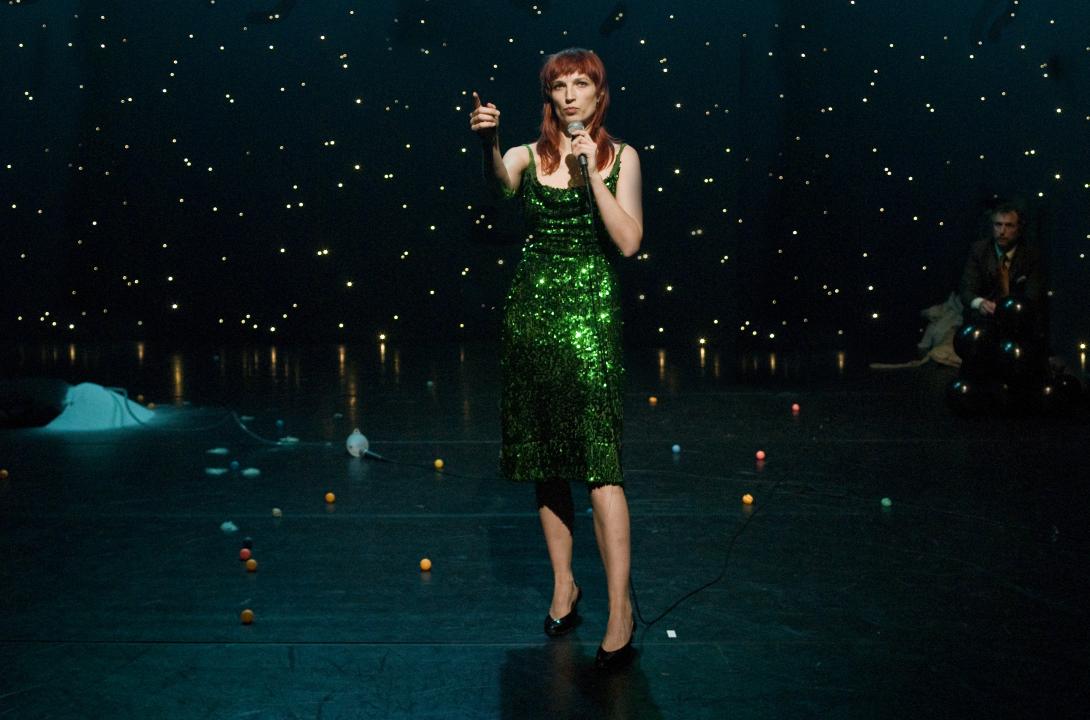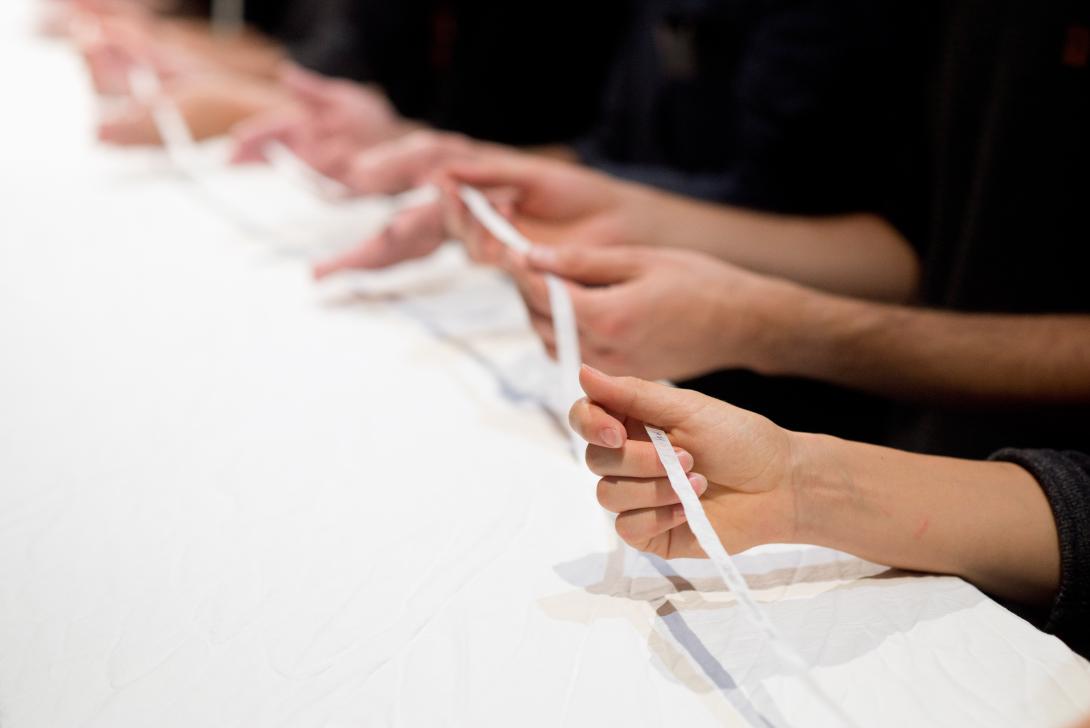‘A WORK CAN HAVE DEPTH BUT IT NEEDS A CLEAR SURFACE’
in conversation with Kate McIntosh
From 23 to 28 October choreographer and artist-in-residence at Kaaitheater Kate McIntosh is presenting three of her pieces in one week: Dark Matter (2009), Worktable (2011) and her latest performance In Many Hands (2016). Together the works show the evolution that has taken place in McIntosh’ practice: from being a stage animal to creating delicate dramaturgies, from silence to words to sound, but also the appearance of a lot of objects. We took advantage of the summer break to invite her for an in-depth interview.
Since Dark Matter – created almost a decade ago – your performances have changed radically: how you use the theatre space, the relationship between performer and audience, the role of the performer, the role you give the audience… How did this evolution start?
I think Dark Matter was the last piece where I really felt that I knew why I was presenting something on stage. The language of stage, being the performer in the middle of it, my relationship with the audience: all these aspects were necessary for what that performance says. After Dark Matter, I become curious about what happens when the performer is no longer the central focus of attention.
Worktable, for example, began with a desire to have no performer and no audience. Just people in action, with no one watching. It probably differs the most from Dark Matter because it doesn’t tell you explicitly what it’s ‘about’ either. Worktable just creates conditions and makes an invitation – then the visitors enter with their safety gear and tools, and each person develops their own relationship to what they’re doing.
Even the time span is not decided by you?
No, the longest Worktable visit took five hours, but some people are finished in 45 minutes. Addressing this time span was part of my curiosity. Often when you work on stage you direct people’s attention in a very concise way, and I wanted to escape that approach. So I thought: how can I make something in which I have no control over people’s attention? So I don’t know what they’re choosing to think about, or how long they’re going to stay. They decide for themselves in what way they want to relate to Worktable.
On the other hand, in my pieces there is always a strong sense of dramaturgy – which structures how ideas and experience are offered. Dark Matter and In Many Hands look completely different to the audience, but their dramaturgical line is always central. It’s the thing I work on the most and I have a similar approach through all these pieces.
It has been several years since you performed Dark Matter, how will it be for you to get back on stage?
It’s very exotic. I’m a stage animal, I trained for that my whole life, but I’m not on stage very often anymore. It will feel like tasting a food I haven’t tasted for a long time. When you’re on stage, you feel the audience strongly. You have the responsibility to read the room constantly and adjust what you’re doing in relationship to that. But in a piece like In Many Hands, the energy between audience and performer is not the focus. The audience is much more independent and sometimes I’m very surprised by what people say afterwards about their experience.
Although you had something else in mind with In Many Hands, the piece ended up being for theatre stages exclusively. How come it turned out like that?
Yes, when we started making In Many Hands, I wanted it to be adaptable to non-theatre spaces. But in the end, the piece concentrates so much on people’s perception and it heightens their sensibility to everything: light, sound, temperature. So we needed an environment that could provide an immersive experience, almost like a laboratory. A theatre turns out to be the place where you can determine all the conditions for playing with your senses, which isn’t possible elsewhere. Funnily enough, the piece is completely non-theatrical but it needs to be presented on a stage.
On the other hand, Dark Matter is my love letter to theatre and everything I enjoy about it: the staging, the smoke, the glamourous costumes, the music. The audience easily recognises that it is a mix of smoky late-night acts and science TV shows. It echoes other theatre experiences and it references popular culture. This is quite the opposite of In Many Hands: when the audience arrives, they have no idea what to expect and never know what’s going to happen next. The question throughout the whole piece is ‘What is happening here? What am I involved in?’ And not in a bad way: that is actually a very enjoyable, useful question. The performance is structured to embrace ‘not knowing’ and to become curious and go exploring.
How did your perception of the audience, what it is and can do, change over the last decade? Did you discover potentialities in the audience that you never noticed before?
In Many Hands and Worktable seem accessible to people who are not regular art spectators. Often when we tour, the audience is quite mixed and not everyone has much viewing experience, especially in small towns or some festival contexts. And yet I notice that people get very involved, and afterwards feel able to speak about it with confidence. This has been interesting for me because it’s not true of all performance work. Sometimes people exit performances saying ‘I don’t know how to relate to this, I feel unqualified to watch’, and I find that problematic.
I like the quote: ‘A work can have depth but it needs a clear surface’. I try to make pieces that are accessible without being simplistic, and are readable from several angles and layers. They should be open to a complexity of different viewings and responses.
Is it the fact that the audience gets another role and is addressed differently that makes Worktable and In Many Hands more accessible?
Maybe, but let’s put it this way: because the formats are not recognizable, I can’t rely on audience members to know what’s going on, so I have to be smart about inviting people in a way that the situation is very clear and available. I can’t make assumptions about what people will understand or how they will behave – as I might in a ‘normal’ stage performance. I’m not afraid of audience discomfort, but I do think thoroughly about how someone might misunderstand what’s going on, or get lost inside it, or disturb someone else’s experience. Actually, that’s a fancy way of saying that I try to avoid excluding or alienating people. Otherwise the piece won’t work. This is also another way to say that if it’s inclusive then it’s also accessible.
The other unusual thing is that the subject matter of both Worktable and In Many Hands is actually the audience themselves. This is very different from a piece like Dark Matter which has a ‘topic’ of enquiry and a clear authorial voice. Instead, the ambition of Worktable and In Many Hands is to set up specific – and quite peculiar – conditions for introspection. They invite people to think through physical action. I’m happy about this quality of introspection – even in a communal sense with In Many Hands. Maybe this is also why the pieces are accessible to all kinds of folks: most people are pretty good at being themselves and are often glad to have space and time to quietly think for themselves.
Sound is quite important in your work too. And sound is also your voice which is still present in Dark Matter but has retreated in Worktable and in In Many Hands.
Yes, sound is extremely important to me, often in pretty subtle ways. Dark Matter uses music, but there is also a big layer of sound which is subconscious, things that you would never notice happening but that produce tension and activate your attention. When I do soundchecks, I want to know whether you feel or see the sound as much as you hear it. For me, sound is a very visceral thing. It tells you where you are in space or it creates a space for you.
Voice work has also been a part of the evolution of my practice. When I was a dancer I didn't speak onstage, but as soon as I started making my own work it was immediately full of language: I talked an enormous amount! I was fascinated by how you can construct images for people by talking, and you can lie. In a positive way: you can just say things and make them true, at least temporarily. But after Dark Matter, I wished for something that was less in my control as a performance maker. I wanted things to happen without being channelled through me or my words. I wanted to make space for kinds of experience. And that’s why we invite people not to speak during In Many Hands, because you can easily rationalise or frame a situation through language – but if you choose not to speak other possibilities open up.
And to close this conversation, what are you working on at the moment?
I have no idea what shape the next project will take and this is really precious to me, I love not to know. But speaking of voices, I’ve become interested in the non-linguistic possibilities of voice: singing, vocal sounds. I am very interested in the musical aspects but also the physicality and even animality of the voice. And I also think it’s time to work without objects for a while, even though it’s been my focus for the past ten years… I’m tired of constantly packing and unpacking!
Kate McIntosh in conversation with Eva Decaesstecker (Kaaitheater, August 2018)
Horrocks, John, ‘A Short History of ‘The New Zealand Intellectual’’ in Laurence Simmons (ed.), Speaking Truth to Power, Auckland University Press, 2007




